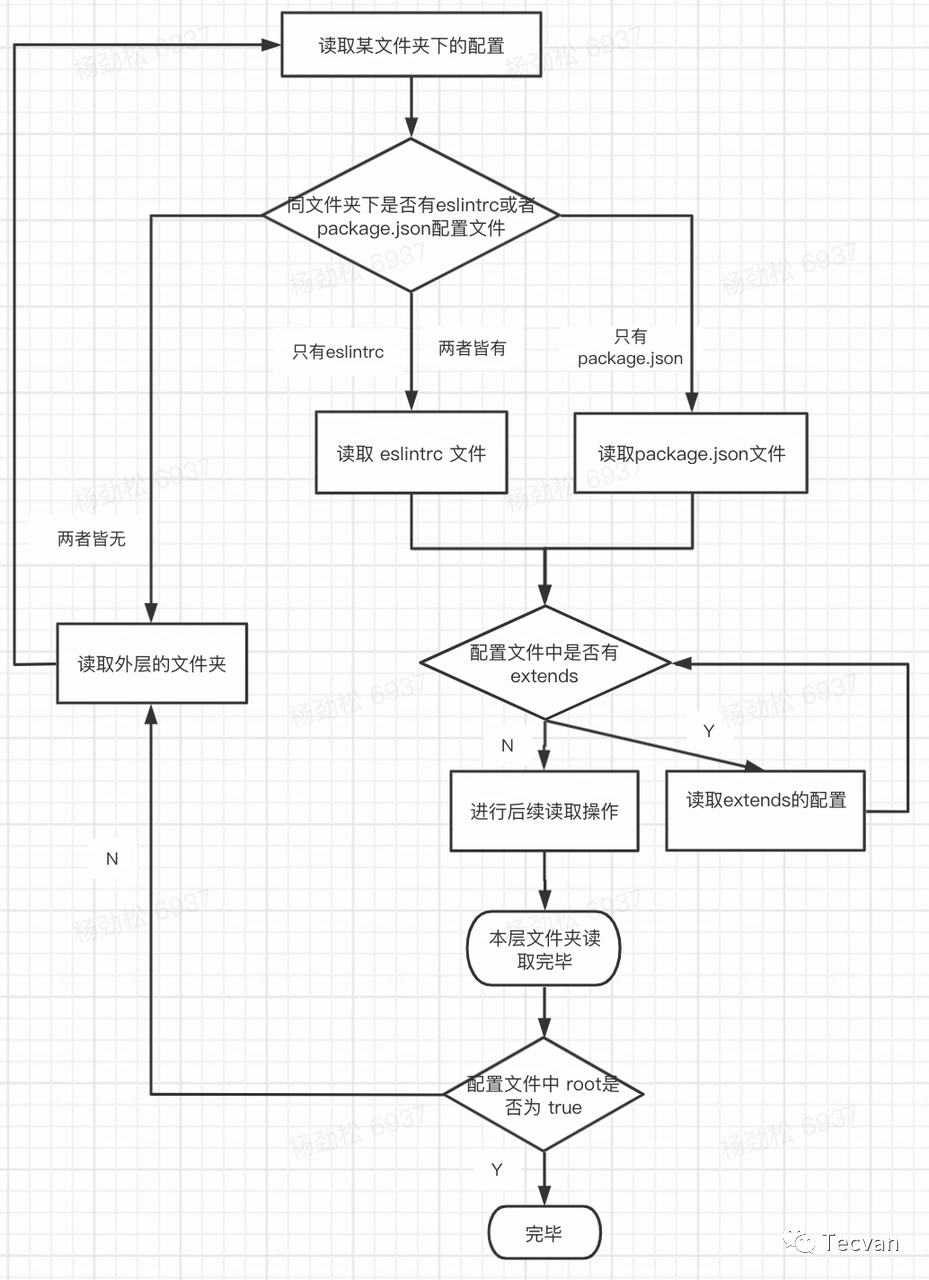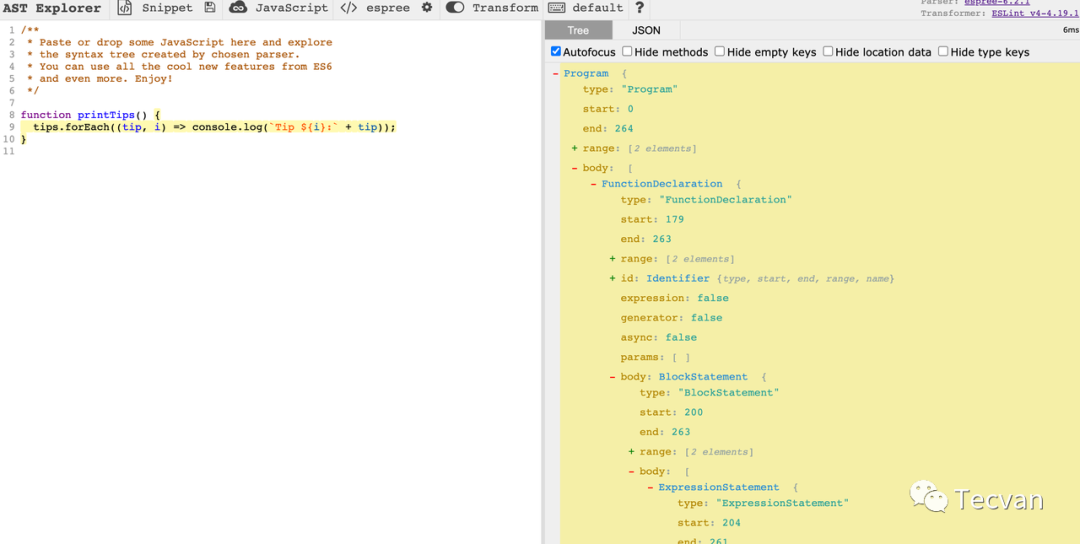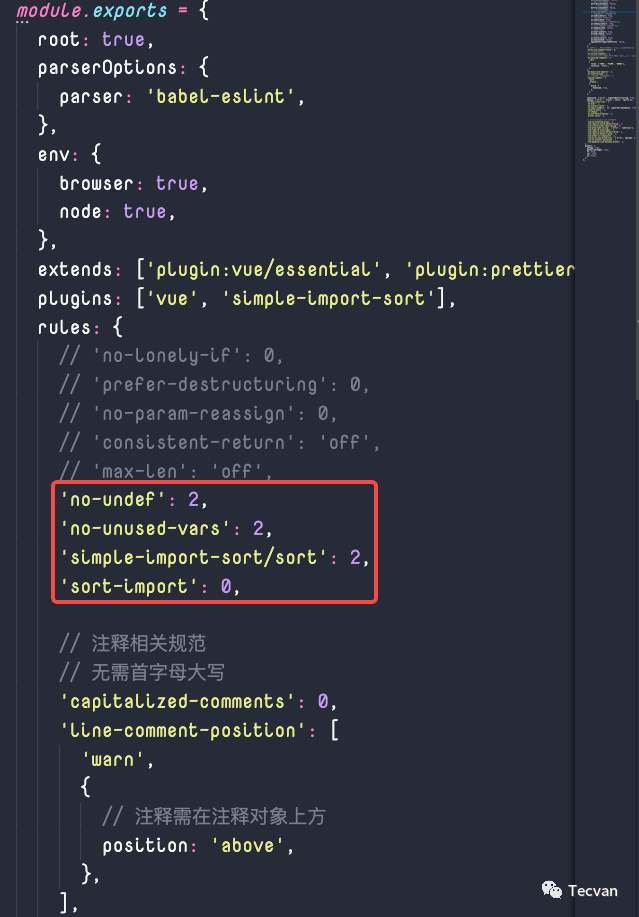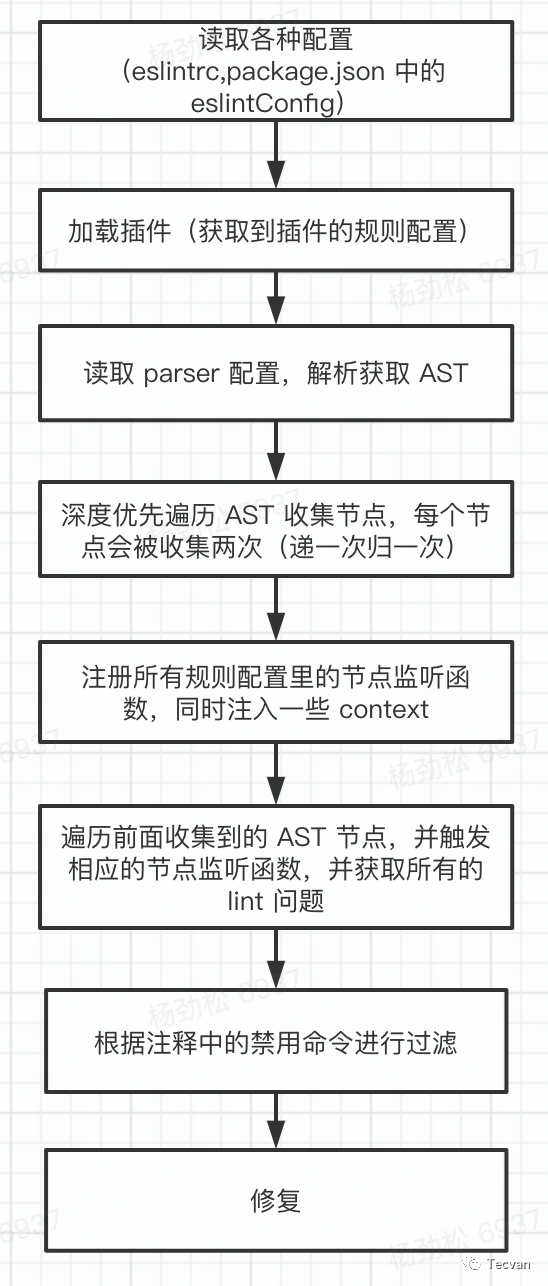
概述
本文将介绍 ESLint 的工作原理,内容涉及 ESLint 如何读取配置、加载配置,检验,修复的全流程。
为什么需要 ESLintESLint
相信大家都不陌生,如今前端工作越来越复杂,一个项目往往是多人参与开发,虽然说每个人的代码风格都不一样,但是如果我们完全不做任何约束,允许开发人员任意发挥,随着项目规模慢慢变大,很快项目代码将会不堪入目,因此对于代码的一些基本写法还是需要有个约定,并且当代码中出现与约定相悖的写法时需要给出提醒,对于一些简单的约定最好还能帮我们自动修复,而这正是 ESLint 要干的事情,下面引用一下 ESLint 官网的介绍。
- 「Find Problems」:ESLint statically analyzes your code to quickly find problems. ESLint is built into most text editors and you can run ESLint as part of your continuous integration pipeline。
- 「Fix Automatically」:Many problems ESLint finds can be automatically fixed. ESLint fixes are syntax-aware so you won't experience errors introduced by traditional find-and-replace algorithms。
- 「Customize」:Preprocess code, use custom parsers, and write your own rules that work alongside ESLint's built-in rules. You can customize ESLint to work exactly the way you need it for your project。
也就是三部分:「找出代码问题」,「自动修复」,「自定义规则」。ESLint 经过许多年的发展已经非常成熟,加上社区诸多开发者的不断贡献,目前社区也已经积累了许多优秀的代码写法约定,为了项目代码的健康,也为了开发人员的身心健康,尽早地引入合适的 ESLint 规则是非常有必要的。
ESLint 是如何工作的
知其然更应知其所以然,ESLint 是如何做到“读懂”你的代码甚至给你修复代码的呢,没错,还是 AST(抽象语法树),大学编译原理课程里我们也学习过它,另外了解 Babel 或者 Webpack 的同学更应该对 AST 很熟悉了。其中 ESLint 是使用 espree 来生成 AST 的。
概括来说就是,ESLint 会遍历前面说到的 AST,然后在遍历到「不同的节点」或者「特定的时机」的时候,触发相应的处理函数,然后在函数中,可以抛出错误,给出提示。
读取配置
ESLint 首先会从各种配置文件里读取配置,例如 eslintrc 或者 package.json 中的 eslintConfig 字段中,也可以在使用命令行执行 eslint 时指定任意一个配置文件。配置文件里的具体可配置项我们下面再详细介绍,这里我们需要注意。
- ESLint 会先读取「给定目录下最近的」一个配置文件。
- 如果相同目录下存在多个配置文件,那这层目录里只有一个配置文件会被读取,其中 .eslintrc 的优先级会高于 package.json 配置。
- 默认会再继续向外层文件夹「逐层读取」配置文件,最终配置合并成一个。
- 其中如果多个配置文件里都配置了重复的字段的话,那离给定目录「最近的配置会生效,」 我们也可以在配置文件中添加 root: true 来阻止 ESLint 逐层读取配置。
以下是读取配置的核心代码:
// Load the config on this directory.
try {
configArray = configArrayFactory.loadInDirectory(directoryPath);
} catch (error) {
throw error;
}
// 这里如果添加了 root 字段将会中断向外层遍历的操作
if (configArray.length > 0 && configArray.isRoot()) {
configArray.unshift(...baseConfigArray);
return this._cacheConfig(directoryPath, configArray);
}
// Load from the ancestors and merge it.
const parentPath = path.dirname(directoryPath);
const parentConfigArray = parentPath && parentPath !== directoryPath
? this._loadConfigInAncestors()
: baseConfigArray;
if (configArray.length > 0) {
configArray.unshift(...parentConfigArray);
} else {
configArray = parentConfigArray;
}
const configFilenames = [
.eslintrc.js ,
.eslintrc.cjs ,
.eslintrc.yaml ,
.eslintrc.yml ,
.eslintrc.json ,
.eslintrc ,
package.json
];
loadInDirectory(directoryPath, { basePath, name } = {}) {
const slots = internalSlotsMap.get(this);
// 这里是以 configFilenames 数组中元素的顺序决定优先级的
for (const filename of configFilenames) {
const ctx = createContext();
if (fs.existsSync(ctx.filePath) && fs.statSync(ctx.filePath).isFile()) {
let configData;
try {
configData = loadConfigFile(ctx.filePath);
} catch (error) {
}
if (configData) {
return new ConfigArray();
}
}
}
return new ConfigArray();
}
加载配置
在上述的 configArrayFactory.**loadInDirectory**方法中,ESLint 会依次加载配置里的extends, parser,plugin 等,其中。
- extends 是其他配置文件,秉着尽可能复用的原则,ESLint 允许我们使用插件中的配置或者是第三方模块中的配置。
- parser 用于解析 AST。
- plugin 则是用户自定义的插件,可以引入自己定义的规则,以及对非 js 文件的检查和处理等。
extends 处理
ESLint 会递归地去读取配置文件中的 extends。那问题来了,如果 extends 的层级很深的话,配置文件里的优先级怎么办?
_loadExtends(extendName, ctx) {
...
return this._normalizeConfigData(loadConfigFile(ctx.filePath), ctx);
}
_normalizeConfigData(configData, ctx) {
const validator = new ConfigValidator();
validator.validateConfigSchema(configData, ctx.name || ctx.filePath);
return this._normalizeObjectConfigData(configData, ctx);
}
*_normalizeObjectConfigData(configData, ctx) {
const { files, excludedFiles, ...configBody } = configData;
const criteria = OverrideTester.create();
const elements = this._normalizeObjectConfigDataBody(configBody, ctx);
}
*_normalizeObjectConfigDataBody({extends: extend}, ctx) {
const extendList = Array.isArray(extend) ? extend : [extend];
...
// Flatten `extends`.
for (const extendName of extendList.filter(Boolean)) {
yield* this._loadExtends(extendName, ctx);
}
yield {
// Debug information.
type: ctx.type,
name: ctx.name,
filePath: ctx.filePath,
// Config data.
criteria: null,
env,
globals,
ignorePattern,
noInlineConfig,
parser,
parserOptions,
plugins,
processor,
reportUnusedDisableDirectives,
root,
rules,
settings
};
}
可以看到,这里是先递归处理 extends,完了再返回自己的配置,所以最终得到的 ConfigArray 里的顺序则是[配置中的extends,配置]。那这么看的话,自己本身的配置优先级怎么还不如extends里的呢?别急,我们继续往下看。ConfigArray 类里有一个extractConfig方法,当所有配置都读取完了,最终在使用的时候,都需要调用extractConfig把一个所有的配置对象合并成一个最终对象。
extractConfig(filePath) {
const { cache } = internalSlotsMap.get(this);
const indices = getMatchedIndices(this, filePath);
const cacheKey = indices.join( , );
if (!cache.has(cacheKey)) {
cache.set(cacheKey, createConfig(this, indices));
}
return cache.get(cacheKey);
}
function getMatchedIndices(elements, filePath) {
const indices = [];
for (let i = elements.length - 1; i >= 0; --i) {
const element = elements[i];
if (!element.criteria || (filePath && element.criteria.test(filePath))) {
indices.push(i);
}
}
return indices;
}
刚刚我们说了,我们通过之前的操作得到的 ConfigArray 对象里,各个配置对象的顺序其实是[{外层配置里的extends配置},{外层配置},{内层配置里的extends配置},{内层配置}],这看起来跟我们理解的优先级是完全相反的,而这里的getMatchedIndices 方法则会把数组顺序调转过来,这样一来,整个顺序就正常了。调整完ConfigArray的顺序后,createConfig方法则具体执行了合并操作。
function createConfig(instance, indices) {
const config = new ExtractedConfig();
const ignorePatterns = [];
// Merge elements.
for (const index of indices) {
const element = instance[index];
// Adopt the parser which was found at first.
if (!config.parser && element.parser) {
if (element.parser.error) {
throw element.parser.error;
}
config.parser = element.parser;
}
// Adopt the processor which was found at first.
if (!config.processor && element.processor) {
config.processor = element.processor;
}
// Adopt the noInlineConfig which was found at first.
if (config.noInlineConfig === void 0 && element.noInlineConfig !== void 0) {
config.noInlineConfig = element.noInlineConfig;
config.configNameOfNoInlineConfig = element.name;
}
// Adopt the reportUnusedDisableDirectives which was found at first.
if (config.reportUnusedDisableDirectives === void 0 && element.reportUnusedDisableDirectives !== void 0) {
config.reportUnusedDisableDirectives = element.reportUnusedDisableDirectives;
}
// Collect ignorePatterns
if (element.ignorePattern) {
ignorePatterns.push(element.ignorePattern);
}
// Merge others.
mergeWithoutOverwrite(config.env, element.env);
mergeWithoutOverwrite(config.globals, element.globals);
mergeWithoutOverwrite(config.parserOptions, element.parserOptions);
mergeWithoutOverwrite(config.settings, element.settings);
mergePlugins(config.plugins, element.plugins);
mergeRuleConfigs(config.rules, element.rules);
}
// Create the predicate function for ignore patterns.
if (ignorePatterns.length > 0) {
config.ignores = IgnorePattern.createIgnore(ignorePatterns.reverse());
}
return config;
}
这里分析一下具体的合并逻辑。
- 对于 parser 和 processor 字段,后面的配置文件会覆盖前面的配置文件。
- 对于 env,globals,parserOptions,settings 字段则会合并在一起,但是这里注意,只有当后面的配置里存在前面没有的字段时,这个字段才会被合并进来,如果前面已经有了这个字段,那后面的相同字段会被摒弃。
例如 [{a: 1, b: 2}, {c: 3, b: 4}] 这个数组的合并结果则是 {a: 2, b: 2, c: 3}。
- 对于 rules 字段,同样是前面的配置优先级高于后面的,但是如果某个已存在的 rule 里带了参数,那么 rule 的参数会被合并。
把 extends 处理完后会继续处理 parser 和 plugin 字段。
parser 和 plugin 处理
这里 parser 和 plugin 都是以第三方模块的形式加载进来的,因此如果我们要自定义的话,需要先发包,然后再引用。对于 plugin,通常约定的包名格式是 eslint-plugin-${name} ,而在在配置中可以把包名中的 eslint-plugin 前缀省略。
_loadParser(nameOrPath, ctx) {
try {
const filePath = resolver.resolve(nameOrPath, relativeTo);
return new ConfigDependency({
definition: require(filePath),
...
});
} catch (error) {
// If the parser name is espree , load the espree of ESLint.
if (nameOrPath === espree ) {
debug( Fallback espree. );
return new ConfigDependency({
definition: require( espree ),
...
});
}
return new ConfigDependency({
error,
id: nameOrPath,
importerName: ctx.name,
importerPath: ctx.filePath
});
}
}
_loadPlugin(name, ctx) {
const request = naming.normalizePackageName(name, eslint-plugin );
const id = naming.getShorthandName(request, eslint-plugin );
const relativeTo = path.join(ctx.pluginBasePath, __placeholder__.js );
// Check for additional pool.
// 如果已有的 plugin 则复用
const plugin =
additionalPluginPool.get(request) ||
additionalPluginPool.get(id);
if (plugin) {
return new ConfigDependency({
definition: normalizePlugin(plugin),
filePath: , // It's unknown where the plugin came from.
id,
importerName: ctx.name,
importerPath: ctx.filePath
});
}
let filePath;
let error;
filePath = resolver.resolve(request, relativeTo);
if (filePath) {
try {
const startTime = Date.now();
const pluginDefinition = require(filePath);
return new ConfigDependency({...});
} catch (loadError) {
error = loadError;
}
}
}
加载流程总结
整个加载配置涉及到多层文件夹的多个配置文件,甚至包括配置文件里的extends ,这里以一张流程图来总结一下。


检验
经过前面的步骤之后,基本上我们已经获取了所有需要的配置,接下来就会进入检验流程,主要对应源码中的 Lint 类的 verify 方法。这个 verify 方法里主要也就是做一些判断然后分流到其他处理方法里。
verify(textOrSourceCode, config, filenameOrOptions) {
const { configType } = internalSlotsMap.get(this);
if (config) {
if (configType === flat ) {
let configArray = config;
if (!Array.isArray(config) || typeof config.getConfig !== function ) {
configArray = new FlatConfigArray(config);
configArray.normalizeSync();
}
return this._distinguishSuppressedMessages(this._verifyWithFlatConfigArray(textOrSourceCode, configArray, options, true));
}
if (typeof config.extractConfig === function ) {
return this._distinguishSuppressedMessages(this._verifyWithConfigArray(textOrSourceCode, config, options));
}
}
if (options.preprocess || options.postprocess) {
return this._distinguishSuppressedMessages(this._verifyWithProcessor(textOrSourceCode, config, options));
}
return this._distinguishSuppressedMessages(this._verifyWithoutProcessors(textOrSourceCode, config, options));
}
不管是哪个分支,他们大致都按照以下顺序执行:
- 先处理 processor。
- 解析代码,获取 AST 和节点数组。
- 跑规则runRules。
下面我们对上面三个过程逐个介绍。
processor
processor 是在插件上定义的处理器,processor 能针对特定后缀的文件定义 preprocess 和 postprocess 两个方法。其中 preprocess 方法能接受文件源码和文件名作为参数,并返回一个数组,且数组中的每一项就是需要被 ESLint 检验的代码或者文件;通常我们使用 preprocess 从非 js 文件里提取出需要被检验的部分 js 代码,使得非 js 文件也可以被 ESLint 检验。而 postprocess 则是可以在文件被检验完之后对所有的 lint problem 进行统一处理(过滤或者额外的处理)的。
获取 AST
当用户没有指定 parser 时,默认使用 espree,若有指定 parser 则使用指定的 parser。
let parser = espree;
if (typeof config.parser === object && config.parser !== null) {
parserName = config.parser.filePath;
parser = config.parser.definition;
} else if (typeof config.parser === string ) {
if (!slots.parserMap.has(config.parser)) {
return [{
ruleId: null,
fatal: true,
severity: 2,
message: `Configured parser '${config.parser}' was not found.`,
line: 0,
column: 0
}];
}
parserName = config.parser;
parser = slots.parserMap.get(config.parser);
}
const parseResult = parse(
text,
languageOptions,
options.filename
);
这里推荐一个网站https://astexplorer.net/,它能方便让我们查看一段代码转化出来的 AST 长什么样。

runRules
正如我们前面说到的,规则是 ESLint 的核心,ESLint 的工作全是基于一条一条的规则,ESLint 是怎么处理规则的,核心就在 runRules 这个函数中。首先会定义nodeQueue数组,用于收集 AST 所有的节点。注意每个 AST 节点都会被推进数组中两次(进一次出一次)。
Traverser.traverse(sourceCode.ast, {
enter(node, parent) {
node.parent = parent;
nodeQueue.push({ isEntering: true, node });
},
leave(node) {
nodeQueue.push({ isEntering: false, node });
},
visitorKeys: sourceCode.visitorKeys
});
然后就会遍历所有配置中的 rule,并通过 rule 的名称找到对应的 rule 对象,注意,这里的两个 rule 不完全一样。「配置中的 rule」指的是在 eslintrc 等配置文件中的 rules 字段下的每个 rule 名称,例如下面这些。

「rule 对象」则指的是 rule 的具体定义,简单来说就是定义了某个 rule 的基本信息以及它的检查逻辑,甚至是修复逻辑,我们在之后的 ESLint 实战介绍中会具体讲解它。总之,这里每个被遍历到的 rule 对象,ESLint 会为 rule 对象里的「AST 节点」添加相应的监听函数。以便在后面遍历 AST 节点时可以触发相应的处理函数。
// 这里的 ruleListeners 就是{[AST节点]: 对应的处理函数}键值对
Object.keys(ruleListeners).forEach(selector => {
const ruleListener = timing.enabled
? timing.time(ruleId, ruleListeners[selector])
: ruleListeners[selector];
emitter.on(
selector,
addRuleErrorHandler(ruleListener)
);
});
为所有的 rule 对象添加好了监听之后,就开始遍历前面收集好的nodeQueue,在遍历到的不同节点时相应触发节点监听函数,然后在监听函数中调用方法收集所有的的 eslint 问题。
nodeQueue.forEach(traversalInfo => {
currentNode = traversalInfo.node;
try {
if (traversalInfo.isEntering) {
eventGenerator.enterNode(currentNode);
} else {
eventGenerator.leaveNode(currentNode);
}
} catch (err) {
err.currentNode = currentNode;
throw err;
}
});
applyDisableDirectives
我们已经获取到所有的 lint 问题了,接下来会处理注释里的命令,没错,相信大家都不陌生,就是 eslint-disable、eslint-disable-line 等,主要就是对前面的处理结果过滤一下,另外还要处理没被用到的命令注释等。
修复
接下来就是修复过程了,这里主要调用SourceCodeFixer类的applyFixes方法,而这个方法里,有调用了 attemptFix 来执行修复操作。这里的 problem.fix实际上是一个对象,这个对象描述了修复的命令,类型是这样的,{range: Number[]; text: string} 。这里我们只需要知道他是由规则的开发者定义的fix函数中返回的对象,所以这个对象描述的修复命令都由规则开发者决定。细节的我们将在之后的实战篇里讲解,这里不再展开。
/**
* Try to use the 'fix' from a problem.
* @param {Message} problem The message object to apply fixes from
* @returns {boolean} Whether fix was successfully applied
*/
function attemptFix(problem) {
const fix = problem.fix;
const start = fix.range[0];
const end = fix.range[1];
// Remain it as a problem if it's overlapped or it's a negative range
if (lastPos >= start || start > end) {
remainingMessages.push(problem);
return false;
}
// Remove BOM.
if ((start < 0 && end >= 0) || (start === 0 && fix.text.startsWith(BOM))) {
output = ;
}
// Make output to this fix.
output += text.slice(Math.max(0, lastPos), Math.max(0, start));
output += fix.text;
lastPos = end;
return true;
}
至此,ESLint 工作的大致流程就已经介绍完了,下面以一张图来总结一下整个流程:
































